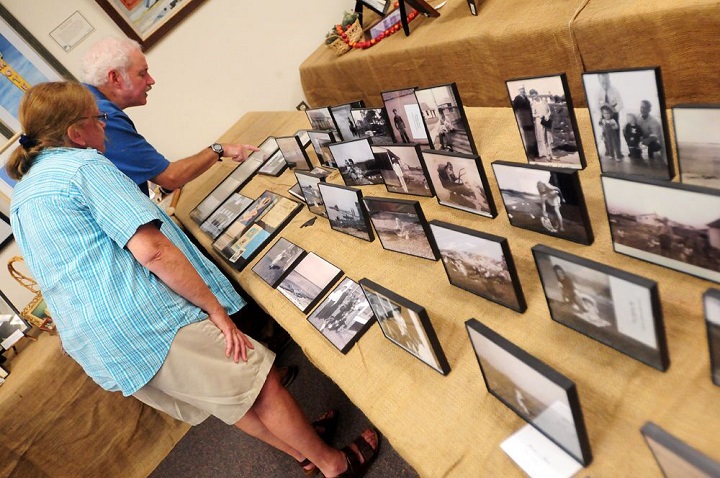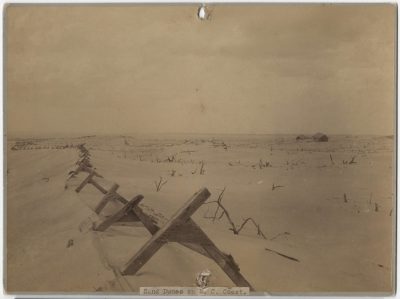
HARKERS ISLAND – The powerful storm that hit the coast 120 years ago this month forced families that called the central North Carolina barrier islands home to uproot their lives and move to the mainland, most ending up on Harkers Island, in Morehead City’s Promise Land and Salter Path.
Often called the San Ciriaco Hurricane because it crossed Puerto Rico Aug. 8, 1899, the morning of Aug. 17 the “Great Hurricane of August 1899,” hit the remote fishing villages of Shackleford Banks, Diamond City and Portsmouth especially hard, according to the excerpt from “North Carolina’s Hurricane History” by historian Jay Barnes featured in Harm’s Way, a digital timeline of the storms that have shaped the coast since the late 1800s.
Supporter Spotlight

“These fishing villages were settled by hardy families who were accustomed to foul weather and remote lifestyles. But numerous hurricanes and northeasters near the end of the century had tested the endurance of the people known as ‘Ca’e Bankers.’ These storms left drifts of barren sand that replaced the rich soils of their gardens, and saltwater overwash killed trees and contaminated drinking wells,” Barnes continues.
“These communities had begun to see a decline in population prior to 1899, largely due to the unwelcome effects of hurricanes. For the residents of Diamond City and Shackleford Banks, the San Ciriaco Hurricane was the final blow.”
They packed up what survived the storm and left.
The uninhabited Shackleford Banks is now a part of the 56-mile Cape Lookout National Seashore, which, along with the Promise Land Society, joined the effort of the Core Sound Waterfowl Museum and Heritage Center on Harkers Island to organize the Diamond City Homecoming Aug. 17.
Held every five years by the waterfowl museum, the event begins at 9 a.m. at Cape Lookout National Seashore visitor center on Harkers Island. From there, visitors will go by ferry to Wade’s Shore, the westernmost part of Shackleford Banks. Reservations are required for the $15 trip. Folks with their own boats are welcome to head over there.
Supporter Spotlight
At 10 a.m. there will be a memorial service at Wade’s Shore Cemetery with music, readings and the sharing of memories, followed by a trip back to the waterfowl museum for lunch at noon. The food trucks are expected to be set up by 11:30 a.m.

Rodney Kemp and descendants of Diamond City will take the stage at 2 p.m. to lead a homecoming celebration.
“We will have a panel discussion on what the Diamond City heritage meant to Promise Landers and Salter Pathers,” said Kemp, president of the Promise Land Society.
The day will close at Cape Lookout Lighthouse. The ferry leaves at 7 p.m. from the park service docks to head to the lighthouse, which will be open for climbing, plus there will be storytelling and time to visit before the 9 p.m. ferries return to the park service docks.
Ferry reservations must be made and are $15 per trip. Tickets for lighthouse climbs, $8, are required. To learn more and make reservations, call 252-723-0982 or 252-728-1500.
Karen Willis Amspacher, executive director of the museum, said Wednesday that this is the first event to be held in the museum since Hurricane Florence struck in September 2018.

The education hall is the only room that is close to ready, she explained, and though there’s no carpet or trim, the walls are painted and there’s air conditioning.
The museum has made some strides since the storm. Last November, the museum had removed at least 75% of drywall and 90% of the flooring in the 22,000-square-foot building. Crews have been working to replace the roof since late May and should be finished anytime now. The artifacts including decoys, artwork, documents, recordings and records were unharmed by the storm and are in storage until the facility is ready.
BG Horvat, Cape Lookout National Seashore chief park ranger, said in an interview that the seashore is “proud to support our partner in this endeavor, and support the descendants of Diamond City in honoring their ancestors who had inhabited this small barrier island community.”
First settled in the early 17th century, the community was first called Lookout Woods but by 1885 was named Diamond City because of the black and white diamonds on the lighthouse. By 1895, Diamond City was thought to have a population of as many as 500, after rapidly growing in the 1850s, due to the whaling industry, Joel G. Hancock wrote in “By the Water’s Edge,” which was included in “Our Shared Past: Diamond City & Ca’e Bankers Reunion,“ a collection of writings about the Shackleford Banks communities to commemorate the century reunion event held Aug. 15, 1999, at the museum.

Hancock continued, saying that while the residents were familiar with the violent storms now called hurricanes, they were not prepared for the “monster storms” that struck in 1896 and in 1899.
“The storm of 1896 started them wondering what to do and yet they waited three more years and felt the effects of the storm of 1899,” according to the late Lillian Davis of Harkers Island, wife of Earl C. Davis, in her “Brief History of Shackleford Banks,” featured in “Our Shared Past.”
“The wind blew from the northeast at first and brought in tides from the sound. Then following hours of that, all was perfectly calm for a short while. Suddenly, the winds shifted to the southwest and again blew as hard or harder than before,” Davis continued. “With the southwest winds came the water from the ocean and the two waters met. This time few, if any, homes were without water in them. When the storm ended, dead sheep and cattle were seen all over as they had drowned.”
“To add insult to the already intolerable injury,” Hancock wrote about the 1899 storm, “the ransacking waters had uncovered graves in the local cemetery and left bones and caskets strewn everywhere.”
Though some residents of Diamond City and Shackleford Banks found their way to other Carteret County communities, many were “unwilling to effect a total separation from the only home most of them have ever known. Their option for a place to rebuild and start anew was directly across Back Sound at a place known as Harkers Island,” according to Hancock, who wrote that for many, staying close to the Banks was for practical as much as sentimental reasons. They were still close to the bays and marshes they knew from working over the years.
The late Alida Willis of the Promise Land community, explained in “The Crowd from Off the Banks,” in “Our Shared Past,” that while most would be drawn to Harkers Island, Marshallberg and Salter Path, “all areas most nearly approximating their known environments,” some ended up in the “’empty pocket’ in the new city of Morehead, bounded roughly by the remnants of those Civil War Breastworks to the east, by the railroad to the north, by the old 15th Street limit to the west, and, most essential to these seafaring people, by Bogue Sound to the South.
“This, then, was the Promised Land.”

When the residents of Morehead City, which was established in the mid-19th century by John Motley Morehead, saw Bankers sailing their homes down Bogue Sound, some were wary of the newcomers.
“To the Bankers, it was imminently practical to take their houses with them – traditional construction had allowed easy dismantling and reassembly. But to Morehead residents, it was unheard of for an entire community to remove to a new location across bodies of water – and take their homes with them over these waters,” Willis wrote. “One prominent city resident, watching yet another dismantled house riding by athwart two sailskiffs, idly remarked to a companion, ‘There go the Israelites on their way to the Promised Land.’”
Some families from Shackleford Banks found their way to the beach community now called Salter Path, because a foot path between the ocean and sound was worn by a Salter household, according to Kay Stephens in her “Salter Path – A Brief History.”
Stephens wrote that families from Down East Carteret County began settling on Bogue Banks in the mid-1800s, but as Shackleford Banks was becoming more inhospitable, some families packed up their houses, in the truest sense, and made their way to Salter Path in March 1896.
The first four families, “Cleared land that was located near the path named for Riley Salter. They took their houses down, brought them by sail skiff to their chosen spot, and reassembled them,” Stephens wrote.
Davis, who recorded interviews with numerous Harkers Island residents to compile her history of Shackleford Banks, said many asked why anyone would live on such a barren beach.
“This would seem strange to those who have never had the pleasure of hearing folks tell about this now barren land as it once was. As long as I can remember, I have been able to picture it as it was when the first people settled there because it was there that my great-grandfathers and their families lived. My grandparents know it as home and my mother lived there until the age of 15,” Davis wrote.
She continued, saying that it was unclear how long the first settlers lived there before the land showed the wear and tear of storms.
“At first they hoped, just as we who have waterfront property hope, the storms wouldn’t come so often. Perhaps they didn’t worry at first when the first trees died from the effects of the storms and the sand from the ocean crept further inland and grass started dying,” Davis wrote. “But the storms continued to sweep the Banks and more trees died, vegetables refused to grow anymore and salt killed the fruit trees. But it wasn’t until the wells began to dry up and large sand dunes formed that they realized the great change taking place all around their homes.”
Amspacher said that this year’s Diamond City homecoming takes on a whole new meaning for the next generation of descendants of Shackleford Banks because of recent storms.
“Now that we have been through the storms of the past decade, we understand their weariness of storms year after year. It is not easy, and we cannot even begin to understand what it was like to experience storms like the Great Storm of 1899 — a Category 5 — on the banks in a wooden shack of a home with no warning and nothing to do but ride it out and pick up the pieces of their homes and boats afterward,” she said.
“Even now, generations after our grandparents and great-grandparents moved for higher ground, we are holding on to those ties to the place where they lived and raised their families, and each other. I am so thankful for all who come to share in this reunion, making sure that our children will understand why Shackleford Banks will always be part of us.” Amspacher said. “I am reminded of Miss Thelma’s poem, ‘Shackleford.’”
“Shackleford”
I stood on a hill, overlooking the sea,
Where a town or village used to be,
I thought of the children who once played there,
Who with their parents worshipped in prayer,
On Shackleford.
I walked over the spot where houses once stood,
Down paths that led through vines and woods,
Where echoed music in years gone by,
As mothers sang to a baby’s cry
On Shackleford.
I found my way to a burial ground,
Now covered with brambles all around,
And I wept for loved ones lying there,
Now free from sorrow, worry and care
On Shackleford.
I climbed a sand dune, and gazed off shore,
And listened to the mighty ocean’s roar,
I recalled tales of storms at sea,
Witnessed by folks who used to be,
On Shackleford.







